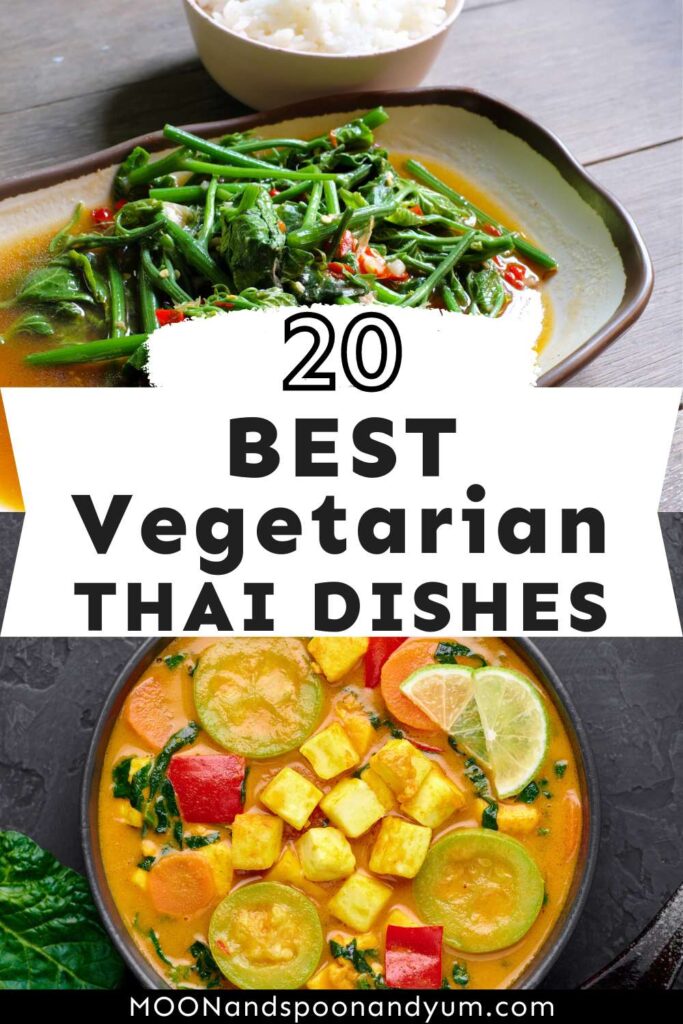20 Best Vegetarian Thai Dishes: Delicious Food For Veggies To Try In Thailand!
Discover the ultimate compilation of the top 20 vegetarian Thai dishes, showcasing delectable flavors and vibrant culinary experiences in Thailand, tailored specifically for vegetarians.
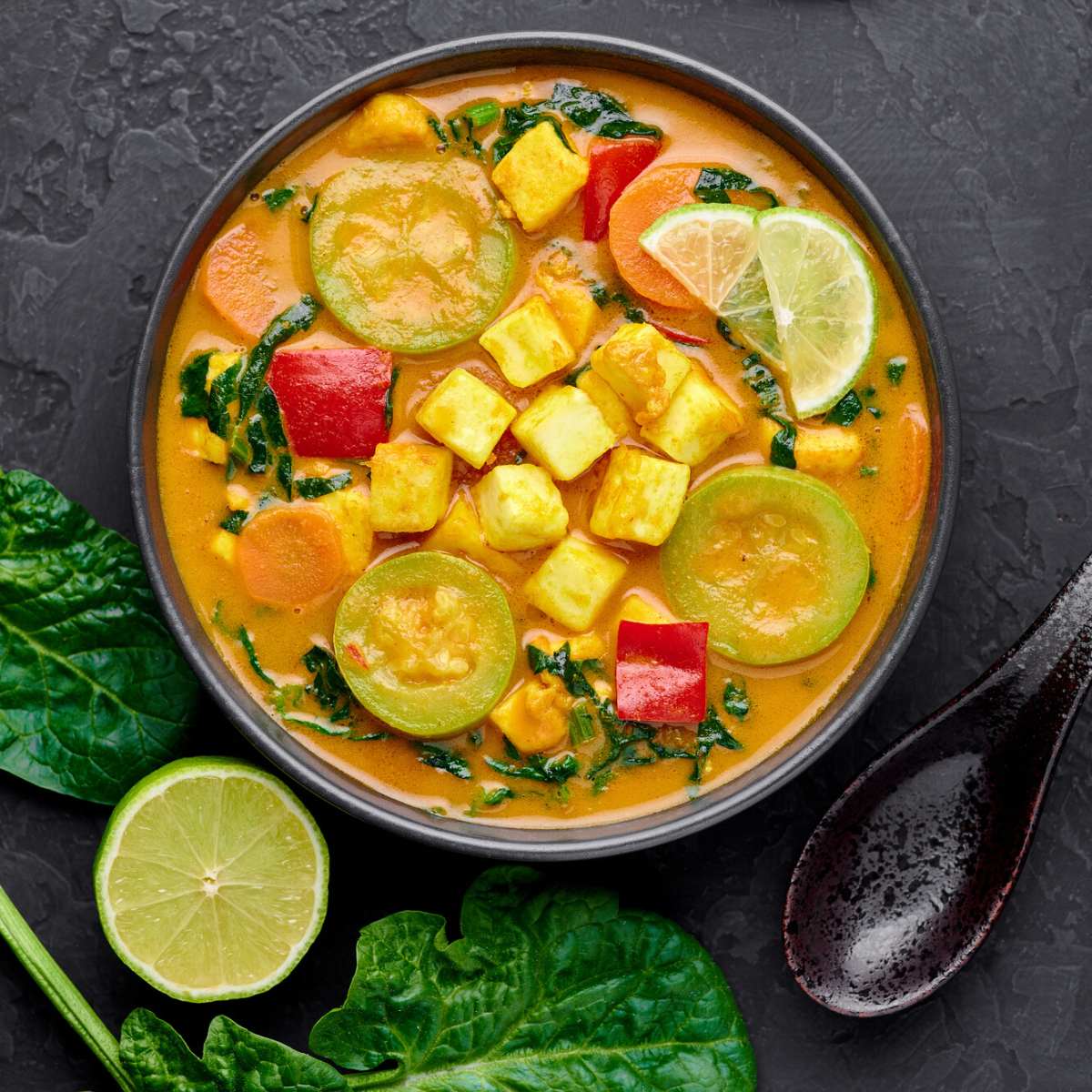
Thailand is a country known for its vibrant and delicious cuisine, but what if you’re a vegetarian?
The good news is that Thailand is a very veggie-friendly country, and while most Thai food isn’t strictly vegetarian, you will find most restaurants will have a vegetarian option.
Some iconic dishes include Pad Thai, Green Curry, Koh Soi, and Vegan Pad See Ew – all of which traditionally are made with meat, but can be made into a vegan or vegetarian option by swapping out the meat for tofu.
So for those who strictly don’t eat meat and are wondering what to eat in Thailand for vegetarians, then this guide is for you.
Below we’ll show you some of the best vegetarian food in Thailand so you can quickly order, without having to customize your meals.
The Best Vegetarian Food in Thailand: Starters, Snacks & Appetizers
When I think of starters, appetizers, or snacks in Thailand my mind instantly conjures up images of street food.
You might think that street food in Thailand is strictly for meat eaters, but that’s not the case. Below are some vegetarian snacks in Thailand that you might want to pick up if you’re feeling peckish.
Note: Many of these side dishes and appetizers can be paired with rice or noodles and made into a main dish.
- Satay Skewers
For a quick and easy snack, look no further than satay. Satay is a grilled meat skewer that’s usually made with chicken or pork but can be made vegetarian with tofu or vegetables – most commonly, shiitake mushrooms.
The skewers are typically served with a peanut sauce which adds a delicious crunch and mouth-watering flavor.
- Por Pia Sod (Thai Fresh Spring Rolls)
Thai Fresh Spring Rolls, also known as Por Pia Sod in Thai, is a popular appetizer or snack made with fresh, raw vegetables and herbs rolled in a delicate rice paper wrapper.
The traditional filling for Thai Fresh Spring Rolls includes a combination of shredded carrots, cabbage, cucumber, bean sprouts, and fresh herbs like mint and cilantro. Some versions may also include cooked vermicelli noodles, tofu, or shrimp (but you can ask to remove this).
The rolls are typically served with a dipping sauce made from a mixture of soy sauce, rice vinegar, sugar, chili, and garlic.
Thai Fresh Spring Rolls are a healthy and refreshing snack as they are low in calories, fat, and cholesterol.
- Tao Hoo Song Kreung (Mixed Tofu)
Tao Hoo Song Kreung features a mix of stir-fried tofu and vegetables. The translation of Tao Hoo Song Kreung means “mixed vegetables and tofu” and it usually contains a variety of vegetables, such as mushrooms, carrots, onions, broccoli, and bell peppers, along with firm tofu that is cut into small cubes.
It’s then typically stir-fried with garlic, chili, and soy sauce to create a savory and slightly spicy flavor. You can enjoy it on its own as a snack, or pair it with rice to make it a full meal.
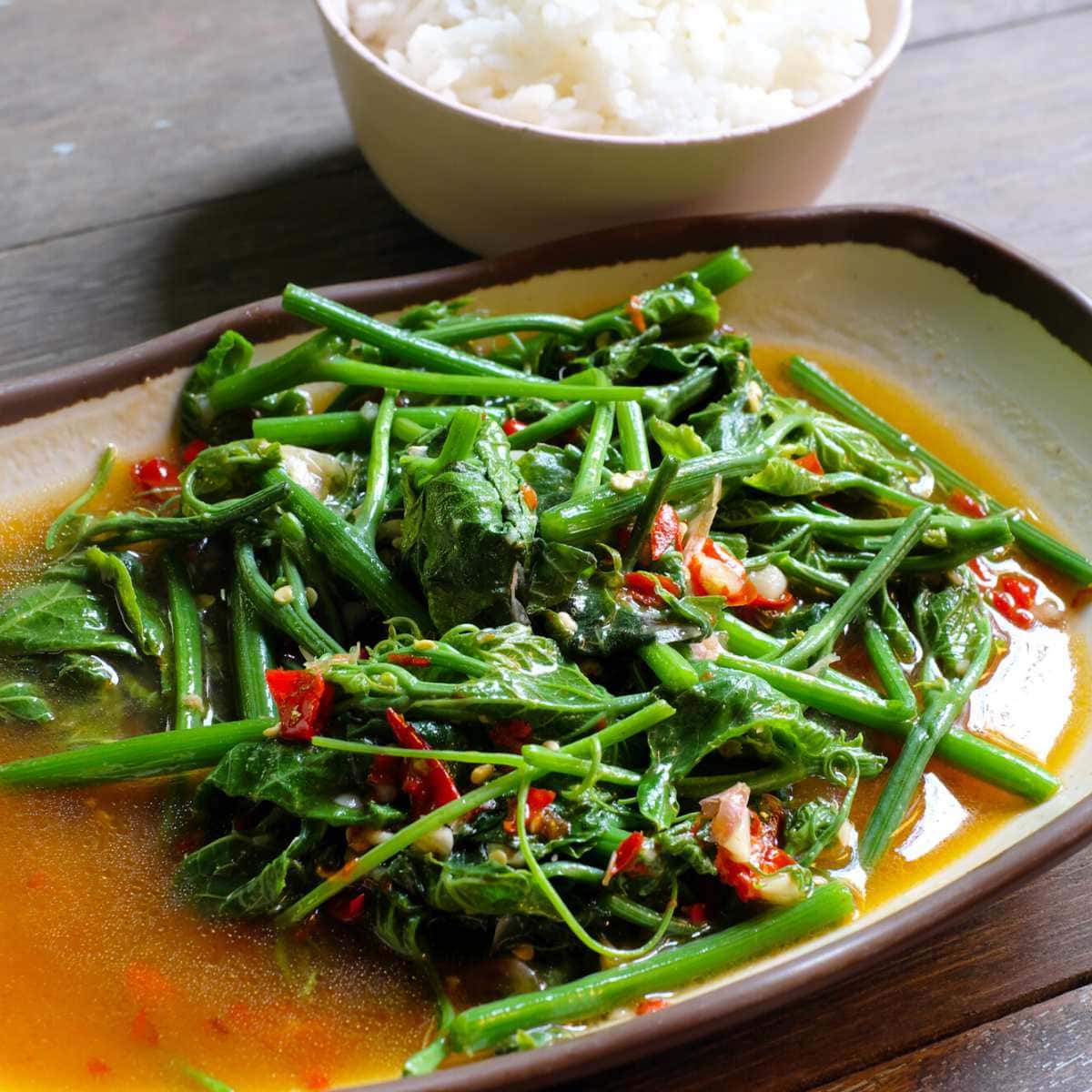
- Pak Boong (Morning Glory)
Pak Boong, also known as Morning Glory, is a leafy green vegetable that is commonly eaten as a side dish in Thailand.
Pak Boong is similar to spinach or kale but has long, thin stems and leaves that are more delicate.
One of the most common ways to prepare Pak Boong is by stir-frying it with garlic, chili, and soy sauce. It’s a simple and tasty dish that is usually paired with other meals, or by adding it to soups and curries.
- Pad Phuk Tong (Stir-Fried Pumpkin)
Pad Phuk Tong is a stir-fried pumpkin dish that is both sweet and savory and is typically served with rice to make it a main meal or kept separate as a side dish.
The pumpkin used in Pad Phuk Tong is typically the golden pumpkin variety, which has a sweet and slightly nutty flavor.
The pumpkin is cut into small pieces or thin slices and stir-fried with garlic, chili, and soy sauce.
Other ingredients like onions, bell peppers, and basil leaves may also be added to give the dish more depth of flavor.
- Pad Phak (Stir-Fried Vegetables)
Pad Phak is simply stir-fried vegetables. The word “phak” in Thai means vegetable, and it’s usually prepared with an assortment of fresh vegetables that are stir-fried with garlic, chili, and soy sauce.
The specific vegetables used in Pad Phak can vary depending on the season and what’s available in the markets that day, but commonly it includes carrots, baby corn, bell peppers, broccoli, onions, mushrooms, and cabbage.
Some versions may also include protein such as tofu.
Pad Phak can be served as a main dish with rice or noodles, or as a side dish to complement other Thai dishes.
- Pad Pak Gachet (Thai Water Style Mimosa)
Something a little more unique and specific to vegetarians is Pad Pak Gachet, also known as Thai Water Mimosa.
It’s typically made with the leaves and stems of the water mimosa plant, also known as kangkong in Southeast Asia.
The dish is prepared by stir-frying the water mimosa leaves and stems with garlic, chili, and soy sauce, and then other vegetables like onions, tomatoes, and peppers are added to enhance the flavor of the dish.
Pad Pak Gachet has a slightly crunchy texture and a mild, earthy flavor that is complemented by the savory flavors of garlic and soy sauce. It is a common side dish that is light and healthy.
- Laab Jay (Vegan Laab)
Being vegetarian in Thailand is quite easy, but being vegan is a challenge. Most dishes are cooked with fish sauce or contain egg, even when no meat is used.
If you want a strictly vegan option, then Laab Jay is a popular favorite.
Laab Jay features a mix of minced mushrooms or soy protein, fresh herbs, and Asian spices. It is a vegan version of the traditional Laab dish, which is typically made with minced meat.
The dish is made by stirring together the cooked minced mushrooms or soy protein with roasted rice powder, lime juice, fish sauce (although this is substituted with soy sauce for the vegan version), chili flakes, and fresh herbs like mint, cilantro, and green onions.
The resulting dish is full of complex flavors and textures, with a balance of spicy, sour, salty, and sweet notes.
Laab Jay is often served with fresh vegetables like lettuce, cabbage, or cucumber, which are used to wrap small bites of the mixture and eaten by hand.
It’s a fun and flavorful snack that can also be eaten as a main meal when paired with rice.
The Best Vegetarian Food in Thailand: Main Meals
For those looking for a main meal or hearty vegetarian dish, these are some of the most popular vegetarian main meals in Thailand…
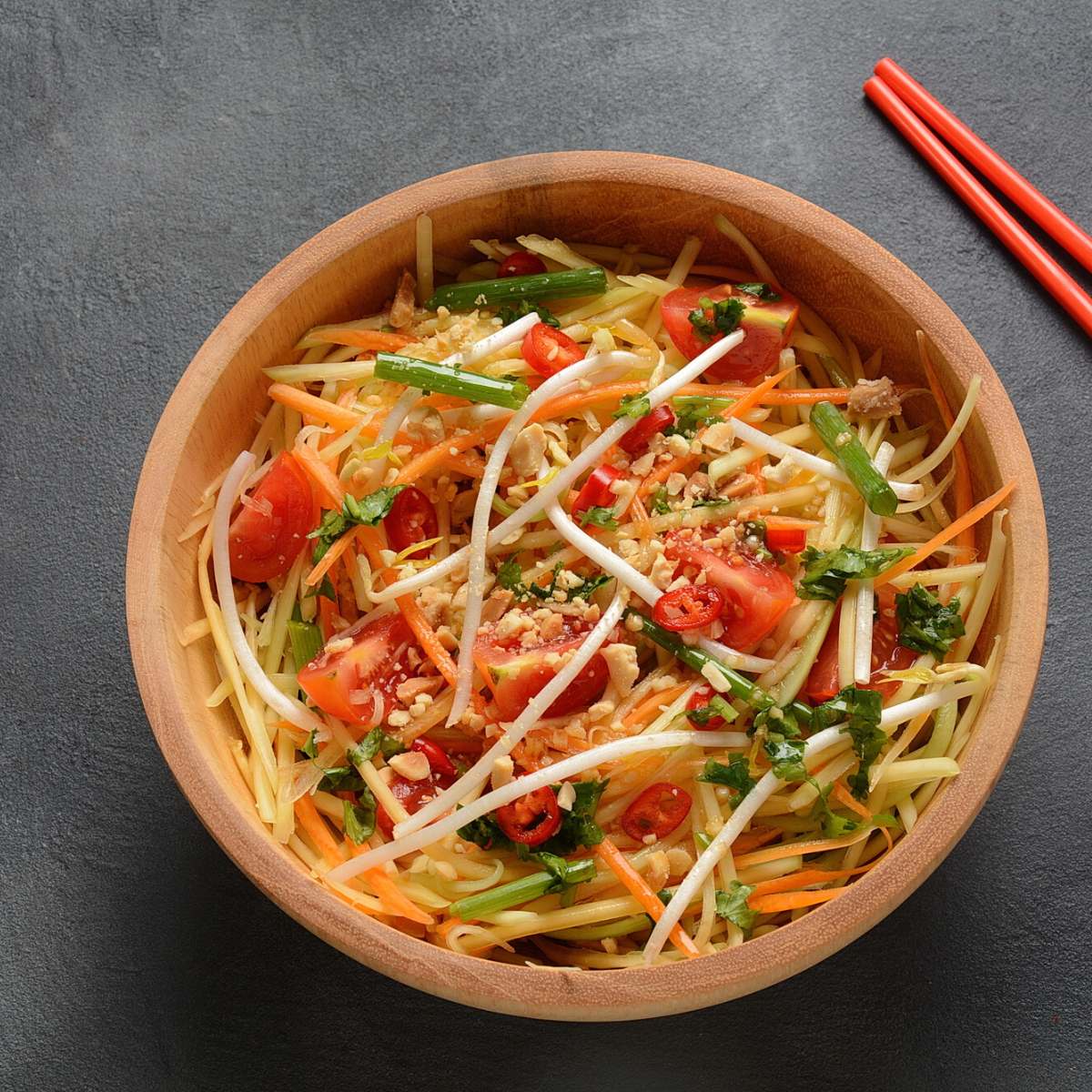
- Som Tam (Papaya Salad)
One of the most popular vegetarian dishes in Thailand is Som Tam, a spicy papaya salad that’s made with shredded green papaya, tomatoes, chili, palm sugar, and lime juice.
Som tam is typically served with sticky rice, making it suitable for a main meal. You can also have it as a starter or side dish.
Papaya Salad may sound refreshing, but be warned, it’s traditionally very spicy. If you can’t handle your heat, be sure to ask for a less spicy version, or “mai ped” which means “not spicy” in Thai.
- Gaeng Om (Panang Curry)
Gaeng Om, also known as Panang Curry, is a rich and spicy curry, typically made with beef, pork, or chicken, but can also be made vegetarian with tofu or mushrooms.
It usually contains carrots, onions, and bell peppers that are cooked in a creamy coconut milk-based sauce.
The sauce is flavored with herbs and spices like kaffir lime leaves, lemongrass, and chili paste.
One of the key ingredients of Gaeng Om is Panang curry paste, which is a blend of herbs and spices like coriander, cumin, garlic, and chilies. This paste gives the dish its distinct flavor and aroma.
However, one thing to consider when ordering a Penang Curry (or any curry in Thailand) is whether the chef is using a packet of sauce or a packet of spices in the dish, as these usually contain MSG.
It’s common for Thai food to contain MSG, but it’s mostly in the spices and sauces, so curries are a big culprit for this.
- Pad Pak Ruam Prik Gaeng (Thai Red Curry)
A red curry is a popular option for those who love curry with heat. It’s made with similar ingredients to Green Curry but with red chilies instead of green, which ramp up the spiciness substantially.
The specific vegetables used in Pad Pak Ruam Prik Gaeng can vary depending on what’s in season, but typically you can expect to find broccoli, bell peppers, carrots, onions, mushrooms, and baby corn.
The vegetables are stir-fried with garlic and ginger before being simmered in the red curry sauce made from coconut milk, red curry paste, and other spices.
The result is a dish that’s both flavorful and nutritious. Pad Pak Ruam Prik Gaeng is usually served with steamed rice, which helps to balance out the spiciness of the curry.
- Pad Gra Pao Het Jay (Spicy Basil With Mushroom)
Spicy Basil is a popular Thai dish that is often served with steamed rice. Pad Gra Pao Het Jay is the vegetarian version and swaps the meat with mushrooms.
The dish is typically made by stir-frying sliced mushrooms with garlic, chili, and Thai holy basil (known as “bai grapao” in Thai), which gives the dish its signature flavor and aroma.
Other ingredients like onions and bell peppers may also be added to enhance the flavor and texture of the dish.
Pad Gra Pao Het Jay is often served with a fried egg on top for extra protein.
One thing to note is that when the dish says spicy, it’s really spicy, so you may want to ask for less spicy (Phed n̂oy) if you don’t like dishes that are too hot.
- Pad Thai
Another popular vegetarian dish is pad thai, which is a stir-fried noodle dish that’s made with tofu, eggs, bean sprouts, and peanuts.
Pad Thai is a staple in Thai cuisine and is a great option for vegetarians looking for something filling and satisfying.
Eggs and protein such as tofu are usually added to vegetarian options, but one of the best things about a pad thai is that it’s versatile and can be customized to suit individual tastes, with extra chili added for those who prefer a spicier dish or less sauce for those who prefer a drier texture.
It’s also a quick meal for those who are really hungry and cannot wait a long time to eat.
If you have a peanut allergy, you can also ask for a peanut-free pad thai which is not too difficult for the chef to do.
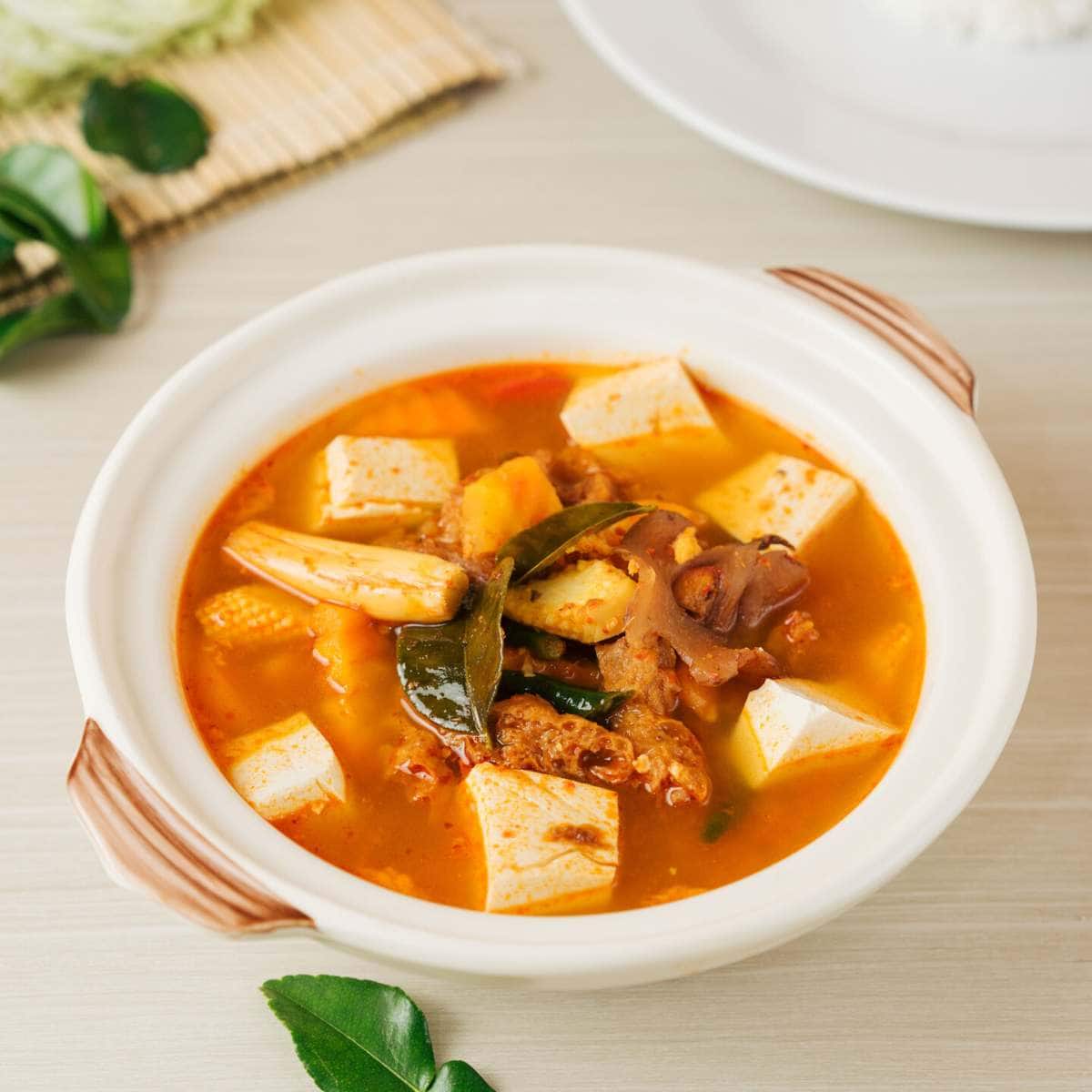
- Tom Yum Soup
If you’re in the mood for soup, then tom yum is one of Thailand’s most famous soup-based dishes.
Tom yum soup is a spicy and sour soup that’s typically made with shrimp but can be made vegetarian by using mushrooms instead. It usually also contains rice noodles.
Thai people don’t usually use chopsticks, except for eating dishes like tom yum soup which is served with slippery rice noodles that are hard to pick up with a spoon.
The sourness of the soup comes from lime juice, while the spiciness comes from chili peppers.
Most vegetarian tom yums will have other vegetables added to them.
Traditionally, tom yum also has bamboo shoots, mushrooms, lemongrass, kaffir lime leaves, galangal, and chili peppers, but veggie options may also have broccoli, green beans, or carrots added to bulk it out.
You can also order a Tom Yum without the soup, which is a stir-fried noodle dish with tom yum flavorings.
- Gang Jay (Vegetarian Curry)
Curries are also a popular choice for vegetarians, especially for those who don’t want a really spicy meal as Thai curries tend to be more creamy than spicy (with the exception of the two aforementioned curries).
You can usually find a vegetarian version of popular favorites such as Green Curry, which is made with coconut milk, green chilies, and herbs such as lemongrass and galangal.
Yellow Curry is the mildest curry which is creamier to taste, or there is the Chiang Mai hometown favorite Massamam Curry or Koh Soi Curry, which again are quite creamy and mild in spice.
All of these popular favorites come with a tofu option in most restaurants, but for vegetarians wanting something more special, you might want to look specifically for Gang Jay.
Gang Jay is a vegetarian curry, also known as Gang Jeud. The word “gang” means curry, while “jay” refers to the Buddhist practice of abstaining from meat and other animal products.
This dish is typically made with an assortment of vegetables, such as baby corn, bamboo shoots, mushrooms, and tofu, cooked in a flavorful sauce made with coconut milk, chili paste, and aromatic herbs and spices like lemongrass, galangal, and kaffir lime leaves.
It’s often served with rice or noodles and is a comforting and hearty meal that will fill you up for hours.
The Best Vegetarian Food in Thailand: Desserts
When it comes to desserts, Thailand has plenty of options. Most desserts are vegetarian if not all of them, but below are some of our favorites.
- Khao Niaow Ma Muang (Mango Sticky Rice)
If you’re looking for something sweet, then you must try mango sticky rice. This is perhaps Thailand’s most famous dessert and is made with sticky rice, coconut milk, and sliced mango.
It’s a delicious and refreshing way to end any meal.
- Kluay Kaek (Banana Fritters)
Kluay Kaek are Banana Fritters that are made by slicing bananas coated in batter and then deep-frying them until crispy and golden brown.
Kluay Kaek is often served with a sweet dipping sauce made from palm sugar, water, and a pinch of salt.
You can usually find Kluay Kaek as a dessert in some restaurants or even as a street food snack.
- Khao Tom Mud (Banana in Sticky Rice)
Khao Tom Mud is a sweet dessert or snack that features sweet sticky rice filled with ripe bananas and steamed in banana leaves.
It’s typically made by soaking glutinous rice in water for several hours or overnight, then mixing it with coconut milk, sugar, and salt.
Ripe bananas are sliced and placed on top of the rice mixture before the whole thing is wrapped in banana leaves and steamed until fully cooked.
The resulting dessert is a sweet and fragrant treat, which although should be a dessert, is also commonly eaten as breakfast.
Make sure the chef has used bottled water when preparing this dessert, as you cannot drink the tap water in Thailand.
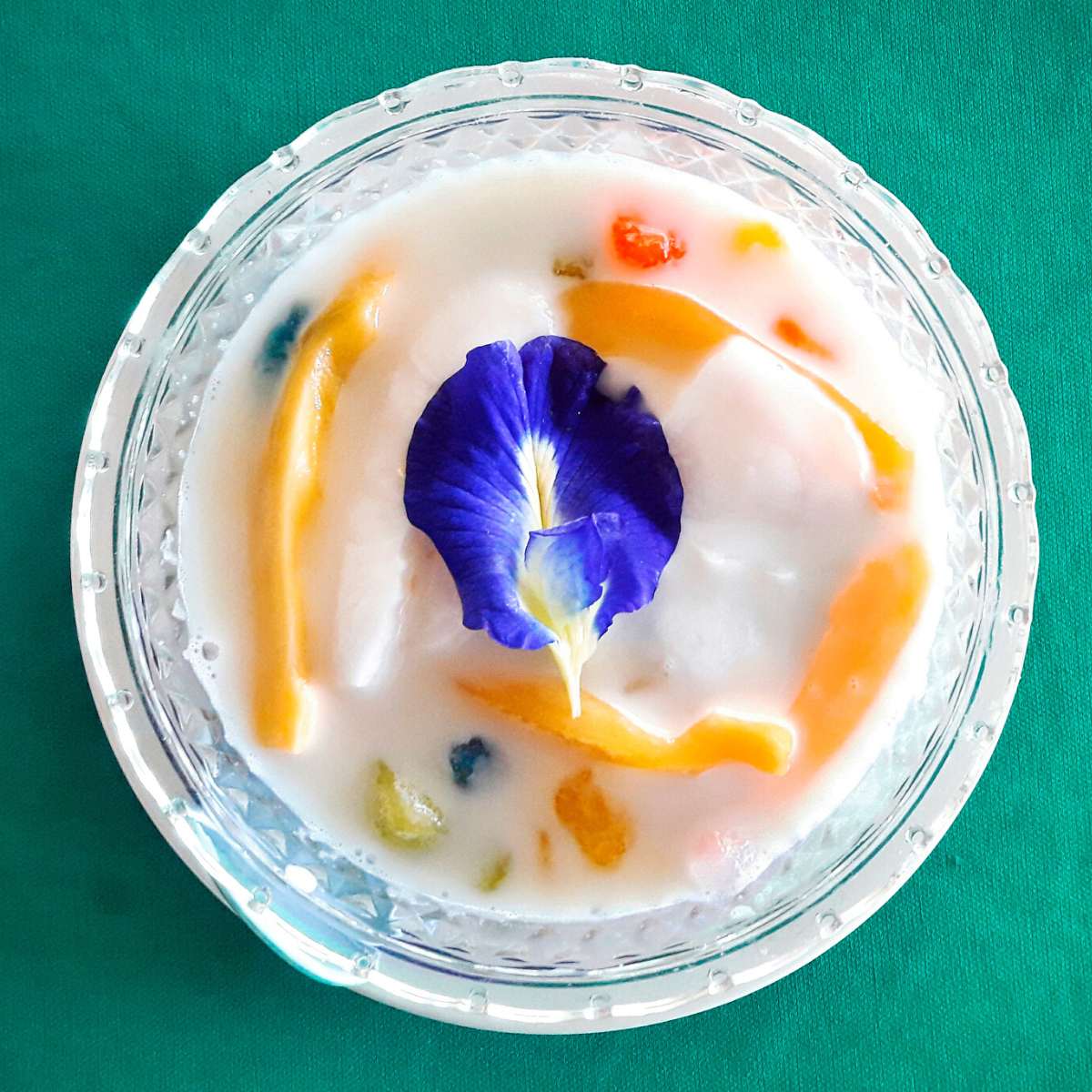
- Tub Tim Grob (Thai Red Ruby Dessert)
Tub Tim Grob is a popular Thai dessert that features red water chestnuts coated in tapioca flour and served in sweetened coconut milk.
The dish is typically made by first soaking peeled and diced water chestnuts in red food coloring until they turn bright red.
The red water chestnuts are then coated in tapioca flour to give them a chewy texture before being boiled in water until they float to the surface.
The cooked water chestnuts are then added to a bowl of sweetened coconut milk, which has been flavored with pandan leaves for extra fragrance.
Tub Tim Grob is often served with crushed ice on top, which adds a cool and refreshing element to the dish. You can also customize it with extra sugar or coconut milk if you prefer sweeter or creamier desserts, but honestly, it’s quite sweet already without this.
- O-aew (Thai Shaved Ice)
Lastly, we have O-Aew, also known as Thai Shaved Ice. This is a dish made with finely shaved ice topped with sweet syrups, fruit, and other toppings.
The shaved ice is placed in a bowl or cup and topped with sweet syrups like condensed milk, fruit syrups, or coconut milk.
You can then customize it according to your taste, but popular toppings include fresh fruit, beans, jelly, tapioca pearls, or corn.
O-aew is often served with a spoon and a straw, so you can taste the different layers as you go through the dish.
FAQs About the Vegetarian Food in Thailand
Here is what people usually ask us about being vegetarian in Thailand…
How do you say “I’m vegetarian” in Thai?”
To tell your server that you’re a vegetarian in Thailand, you should say “ben mang sa wirat” which means “I’m a vegetarian.” Or you can say “mai gin neua sat” which means “no meat at all.” This will ensure your meal does not contain any meat at all. It’s important to tell your waiter this as sometimes pork floss is used as a garnish, even on meals advertised as vegetarian.
How many people in Thailand are vegetarian?
In 2019, it was estimated that around 8% of the Thai population categorized themselves as non-meat eaters.
When is the Vegetarian Festival in Thailand?
The Vegetarian Festival, also known as the Jae Festiva in Thailand, is celebrated annually in October. The dates change each year according to the Chinese calendar, as it falls in the ninth lunar month.
What vegetarian restaurant chains are there in Thailand?
May Kaidee May Kaidee is a popular vegetarian restaurant chain that has locations throughout Thailand. They offer a variety of vegetarian and vegan dishes, including curries, stir-fries, and soups. For vegans, look for Veganerie Concept, a popular vegan restaurant chain that has locations in Bangkok and Pattaya.
Final Thoughts
You’ll find that vegetarian food in Thailand is plentiful and delicious. Whether you’re in the mood for spicy papaya salad or creamy green curry, there’s something to satisfy any craving.
You’ll find that finding veggie meals is easy and most restaurants have a customizable menu so you can remove the meat and swap it for tofu.
In fact, I would say Thailand is one of the easiest countries in Southeast Asia to be vegetarian in, especially since it hosts a vegetarian festival each year in October.
I hope you found this guide helpful, and if you have any more questions, feel free to reach out to us in the comments.
Images in this post are courtesy of Depositphotos.

